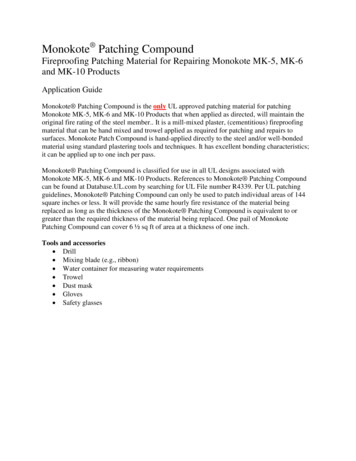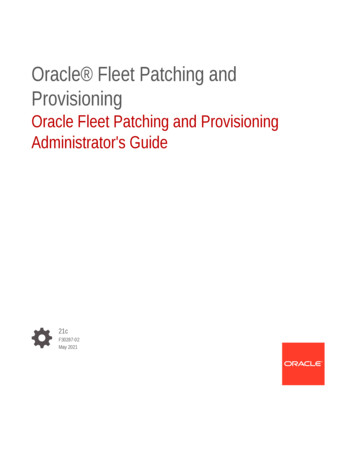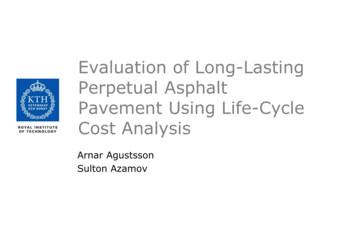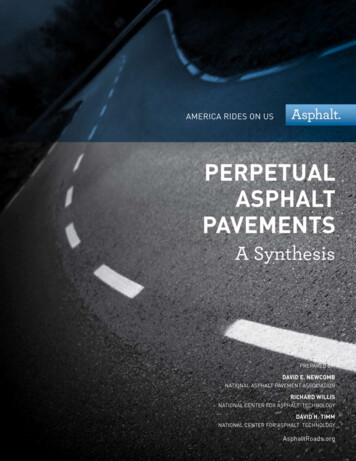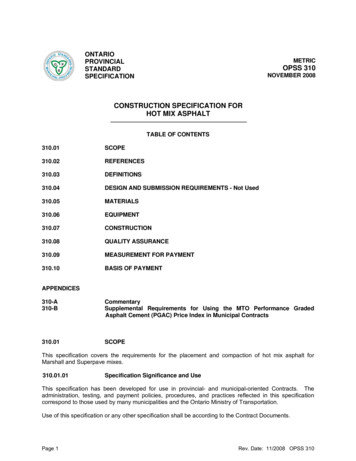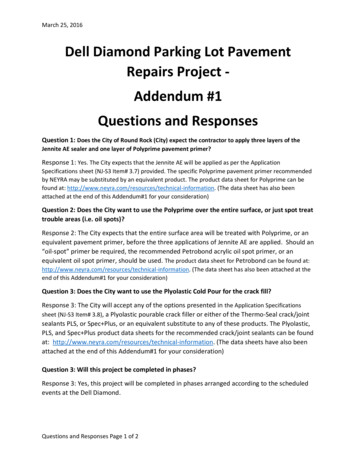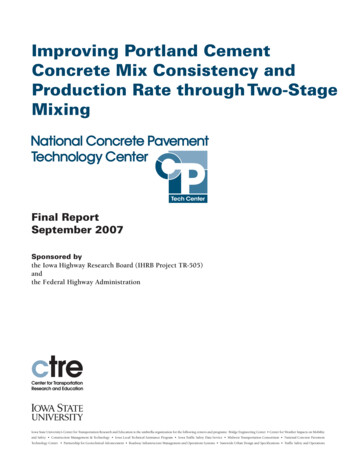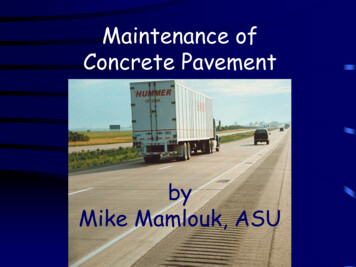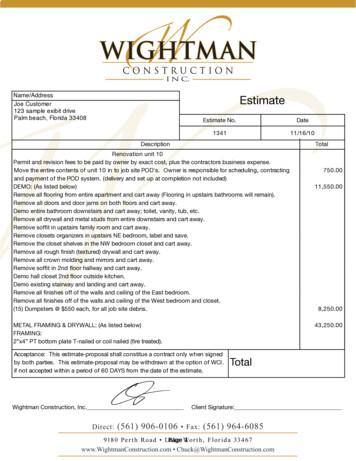
Transcription
Chapter 33-1Pavement Patching and RepairGeneralThe roadway is defined as the area between the outer limits of side slopes or otherwiseimproved portion of a public highway ordinarily used for vehicular travel. A roadwaysurface is normally classified as flexible (consisting of asphaltic materials) or rigid(consisting of Portland Cement Concrete) pavement.It is desirable that the roadway surface provide a safe, smooth driving surface withgood skid resistance for the people we serve. Roadway distress such as alligator cracks,pumping, pushing, wheel rutting, raveling, frost heaves, and pot holing are defects thatneed to be addressed.Maintenance of the state’s roadways is the primary way that unwanted pavementdistresses are reduced or eliminated. Preferably, the maintenance of pavement shouldbe accomplished with minimum expense and the least possible traffic disruption.Maintenance of pavements is a necessary investment performed to prevent costlyrenovation or reconstruction.Preventive maintenance is the most cost effective way to extend pavement performanceand minimize the need for future costly major repairs. Area maintenance staff are requiredto inspect each section of highway at least once a year to detect and schedule deficiencyrepairs prior to becoming a major problem.The intent of this chapter is to communicate the benefits of pavement preservation inthe life of a pavement and to identify pavement distress. It must be noted that properdocumentation and communication is of greatest importance. This will be developed ingreater detail as this chapter progresses.3-2ReferenceStandard Specifications for Road, Bridge, and Municipal Construction M 41-10Asphalt InstituteWSDOT Maintenance Manual M 51-01.11September 2020Page 3-1
Chapter 33-3Pavement Patching and RepairResourcesHeadquarters Maintenance OfficeRegional and Area Maintenance Offices/CrewsRegional Materials OfficeConstruction Manual M 41-01Design Manual M 22-01WSDOT Pavement PolicyAsphalt Institute -4The Asphalt HandbookIntroduction to AsphaltAsphalt Paving ManualAsphalt cold-Mix ManualDrainage of Asphalt Pavement StructuresAsphalt in Pavement MaintenanceAsphalt Overlays for Highway and Street RehabilitationBasic Asphalt Emulsion ManualCommunicationThe Washington State Legislature provides biennial appropriations conforming to aspecific, (LOS) Level of Service for roadway maintenance and operations activities.The maintenance area’s roadway surface program needs to be managed to meet theLOS commitments.In doing so, it is essential that each Region Maintenance Area work in combination withits Program Management, Materials, Design and Construction offices to ensure thatMaintenance projects are coordinated with the work that these offices are planning and/or constructing in the Capital Program.It is advised that written recommendations for pavement repairs be submitted to theRegional Maintenance Engineer. The Regional Maintenance Engineer will then sharethe region wide roadway surface maintenance program with the Regional Materialsand Regional Construction Engineer. This allows better coordination between themaintenance and construction programs. As a result of this coordination reoccurring areasof pavement failure can be eliminated.Page 3-2WSDOT Maintenance Manual M 51-01.11September 2020
Pavement Patching and Repair3-5Chapter 3Integrated Pavement PreservationWashington State has adopted an integrated approach to pavement preservation.Integrated pavement preservation looks at the overall pavement life-cycle and is aplanned approach to pavement preservation and pavement maintenance. Because theterminology of preservation and maintenance can vary based on context, the following ishow the FHWA defines the two:Preservation: Preservation consists of work that is planned and performed to improveor sustain the condition of the transportation facility in a state of good repair.Preservation activities generally do not add capacity or structural value, but do restorethe overall condition of the transportation facility.Maintenance: Maintenance describes work that is performed to maintain thecondition of the transportation system or to respond to specific conditions or eventsthat restore the highway system to a functional state of operation. Maintenance is acritical component of an agencies asset management plan that is comprised of bothroutine and preventive maintenance.As well as structuring funds so they can be moved in a timely manner for plannedmaintenance, the success of this approach relies on decision making and timing ofmaintenance activities. Integrated Pavement Preservation consists of PreventivePreservation, to include Strategic and Emerging Preservation, and Reactive Preservation.3-5.1Preventive PreservationPreventive Preservation is planned and coordinated maintenance that is typicallyperformed early in a pavement life and is intended to extend pavement service life 1 to 6years. Planning occurs between the Region Maintenance Engineer, the Region MaterialsEngineer, the HQ Pavement Office and Capital Program Development and Management(CPDM).Preventive Preservation includes Strategic Preservation and Emerging Preservation.The following is an example of a typical Strategic Preservation Maintenance (P1-M)schedule for a biennium.WSDOT Maintenance Manual M 51-01.11September 2020Page 3-3
Chapter 3Pavement Patching and RepairStrategic Pavement Preservation Maintenance (P1-M) Schedule - 21-23 BienniumStart6/1/2019EndOrganizationDescription of Work8/15/2019 Region Program Development Region Materials ReviewDuration(Days)758/16/2019 9/30/2019 Region Program Development Provides proposed changes toWSPMS from the notes of RegionPavement Review4510/1/2019 10/31/2019 Region Maintenance30Region 21-23 pavementmaintenance needs, including P1and M211/1/2019 7/31/2020 Region Program Development Develop 10-year P1 (Preservation)Region Materials LabPlan (expect schedules to adjust)2737/31/2020 7/31/2020 Region Program Development Publish the 2-year P1 PreservationProject List to Region Materials andRegion Maintenance08/1/20208/31/2020 Region Program Development Develops the Region StrategicRegion Materials LabPreservation Maintenance List (P1M and M2)309/1/202010/31/2020 Region Materials Lab RegionMaintenanceConduct field reviews of theRegion P1-M list and providerecommendations to HA Mats Labfor approval6011/1/2020 11/30/2020 HQ Materials Lab - Pavement Review the P1-M List and provideOfficecomments/concurrence2912/1/2020 12/31/2020 HQ Materials Lab - Pavement Finalize the 21-23 P1-M ListOffice Region ProgramDevelopment RegionMaterials Lab RegionMaintenance3012/1/2020 4/30/2021 Region Maintenance150Begin environmental review/permitting process1/1/20214/30/2021 Region MaintenanceDevelop the P1-M cost estimatesinto HATS Feature Activities.HQ coordinates with HQ MatsLab for WSPMS upload. RegionMaintenance coordinates withConstruction Traffic Control Office.5/1/20215/31/2021 Region Program DeliverySend WOA to CPDM306/1/20216/30/2021 CPDMApproves and setup the work orderand groups297/1/20216/30/2023 Region MaintenanceExecutes the 21-23 P1-M List;begins reporting unit costs729Page 3-4119WSDOT Maintenance Manual M 51-01.11September 2020
Pavement Patching and RepairChapter 3It must be stated that there are limitations and parameters set for the funding of P1-Mprojects. These limitations can change and include, but are not limited to, average dailytraffic (ADT), chip seals, ramps, and total dollars to be spent.3-5.2Strategic PreservationThis work is primarily completed early in the pavement life cycle to within 4 years beforea planned (Capital Preservation) project. Strategic Preservation work may be completedunder Contract or by Maintenance.Examples of Strategic Preservation for flexible pavements would include crack seal, masticseal, chip seals, wheel path chip sealing. For rigid pavements, strategic preservation mightinclude spall repair, corner break and or partial depth repairs.3-5.3Emerging PreservationThis work is completed with M2 funding and performed by WSDOT Maintenance. Theintent of this work should be to reduce the need for future Reactive Preservation andextend pavement life.Emerging Preservation work focuses on areas of pavement that are predicted to failwithin a year if maintenance is not performed.Emerging Preservation work might include digouts, grader patching, and millingfor flexible pavement as well as partial depth or full depth panel replacement forrigid pavement.3-5.4Reactive PreservationThis work is completed using M2 funding and performed by WSDOT Maintenance.Reactive Preservation is unplanned, “emergent” and maintenance work that is done tocorrect immediate needs.Since Reactive Preservation is emergent and needs to be quickly addressed, the mosttypical technique is pothole patching where cold patch or possibly a grader patch is usedto hold the pavement distress until a more effective treatment can be placed.The easiest way to summarize pavement preservation as it relates to maintenanceactivities is to say that this work mainly involves Emerging and Reactive Preservation.WSDOT Maintenance Manual M 51-01.11September 2020Page 3-5
Chapter 33-6Pavement Patching and RepairHATSIn order to properly document areas of pavement repair need and prepare for work tobe completed, a system of mapping pavement distress for planned activities has to bein place.HATS is the program used to collect the needs of pavement maintenance and to estimatebudgetary requirements. The data contained within HATS provides a complete recordof planned activities which can be used to estimate the funding needed to completeidentified maintenance program activities.The other benefit of the HATS program is that it can be used to compare when andwhere a Capitol Preservation or P1 maintenance project is going to occur. By havingclearly defined HATS information available, programming can occur as to whether or notemerging treatment will even be needed.3-7Pavement DistressesEnvironment and traffic loading are the primary cause of pavement distress, but damageand deterioration of pavements can result from numerous other factors. For example, anoverlay with poorly graded or inadequately fractured aggregate and low asphalt contentmay not have adequate particle interlock; thus cracking and oxidation may develop.Poor subgrade drainage, overweight loads, and accelerating or decelerating traffic are allpotential sources of surface irregularities.The WSDOT collects pavement condition data of the existing roadways using thePavement Distress Identification Van. Distress measurement data is collected, processed,then analyzed and input within the Washington State Pavement Management System(WSPMS).Pavement distress is measured according to the Pavement Surface Condition RatingManual (pdf 3.32 mb), however; the following are brief descriptions and examples ofvarious pavement distress. It is always best to consult with your respective RegionMaterials Engineer if you are not sure about the type or cause of distress or the properrepair needed.Page 3-6WSDOT Maintenance Manual M 51-01.11September 2020
Pavement Patching and Repair3-7.1Chapter 3Longitudinal CrackingA longitudinal crack runs approximately parallel to the roadway centerline. These aretypically a result of traffic loading or HMA with inadequate asphalt content.Exhibit 3-1Longitudinal CrackingThis type of crack is usually a non-working crack that can be treated with a crack sealingmaterial. It is highly recommended that these cracks are filled before getting to a widthgreater than a 1/2 inch to reduce sealant cost. Although this is the most cost-effectivetreatment option available, attempting to seal cracks that are greater than 3/4 inch isnot recommended.WSDOT Maintenance Manual M 51-01.11September 2020Page 3-7
Chapter 33-7.2Pavement Patching and RepairTransverse CrackingTransverse cracks run roughly perpendicular to the roadway centerline. They are usuallycaused by surface shrinkage caused by low temperatures, hardening of the asphalt, orcracks in underlying pavement layers such as PCC slabs. They may extend partially or fullyacross the roadway.Exhibit 3-2Transverse CrackingTransverse cracks are most typically a working crack and sealing these cracks with arubberized material is the most effective treatment option, although crack sealing is analternative if a mastic material is used.Page 3-8WSDOT Maintenance Manual M 51-01.11September 2020
Pavement Patching and Repair3-7.3Chapter 3Alligator CrackingThe condition of alligator cracking is reached when irregular longitudinal cracks begin tointerconnect to form a series of small blocks that resemble an alligator’s skin. This distressis associated with traffic loading and is usually rooted in poor construction, poor drainage,subgrade failure, or the pavement may have just reached the end of its life. If neglected,full-depth distress can be observed when subgrade material is forced up through thesurface leading to depressed pavement and an eventual pothole.Exhibit 3-3Alligator CrackingIf the alligator cracking isn’t extensive, subgrade material isn’t visible and signs ofdepressed pavement isn’t present, a chip seal might be a possibility. The typical repairmethod, however; is to complete a partial-depth or full-depth patch. Full-depth crackingextends through the entire pavement structure, whereas partial-depth cracking goesthrough a portion of the pavement.WSDOT Maintenance Manual M 51-01.11September 2020Page 3-9
Chapter 33-7.4Pavement Patching and RepairPotholesPotholes are voids in the roadway surface where pieces of the pavement have becomedislodged. Areas in which many potholes occur become suspect for fundamental problemssuch as inadequate drainage, pavement strength, or base/subgrade problems. Single orinfrequent potholes may be the only pavement distress to occur in an area, and beyondthe treatment of the individual pothole no other pavement repair work may be required.If potholes occur in a systematic or cyclic manner, these are typically a result of theconstruction process.Exhibit 3-4PotholesPothole repairs will generally be full-depth patches but care should be taken to confirmthat they are full-depth. The repair area will always need to extend beyond the limit of thevisible distress in order to get to sound material. If repairs only include the affected area,reoccurring distresses typically result.Page 3-10WSDOT Maintenance Manual M 51-01.11September 2020
Pavement Patching and Repair3-7.5Chapter 3Raveling and PittingRaveling and pitting distresses are characterized by the loss or dislodgment of surfaceaggregate particles. This usually results from HMA that is designed with too little asphaltor overheating of the mix during manufacture. It can also occur by oxidized asphalt binderinitiated by poor compaction, letting the mix get cold when paving, dirty aggregate, orpaving too late in the construction season. The most important consideration with thisdistress is to perform repairs before a more serious condition develops, and prior tothe onset of inclement weather because this pavement distress is a good indicator ofnegatively permeable pavement. A pavement that is raveling must be sealed as soon asreasonably possible since unsealed pavements will continue to ravel, age and hardenmuch faster than normal resulting in difficult maintenance problems.Exhibit 3-5Raveling and PittingThe best treatment option for a pavement that is raveling or pitting is to perform a fogseal to ensure the pavement has been sealed and thereby reduce the rapid deteriorationusually exhibited from this distress. If raveling becomes severe a chip seal is an alternative.WSDOT Maintenance Manual M 51-01.11September 2020Page 3-11
Chapter 33-7.6Pavement Patching and RepairFlushingFlushing (or bleeding) is free asphalt on the surface of the pavement indicated by a shiny,glass like surface. There are many causes such as too many fines in the mix, too few voids,too much asphalt in patches, underlying distress that is allowing moisture to strip theasphalt from the aggregate, or a chip seal that has lost its rock. It is inherent to unstablemixes and often results in other roadway surface distress, such as rutting, if not corrected.Exhibit 3-6FlushingRemoval and replacement of flushed or bleeding pavement areas is an expensive, butsometimes cost-effective method of repair. Another option is to perform a chip seal withminimal or no emulsion but this approach necessitates proper prior planning. If repairsare not possible prior to a seasonally wet period, contact the regional traffic engineer toevaluate friction and the need for posting “Slippery When Wet” signs.Page 3-12WSDOT Maintenance Manual M 51-01.11September 2020
Pavement Patching and Repair3-7.7Chapter 3RuttingRutting is a surface depression within the wheel path and is a result of permanentdeformation of the pavement or subgrade. This condition is normally caused by heavyloads on roads lacking sufficient strength to support the loading but can also occur as aresult of HMA with too much binder in addition to studded tire use. Wheel ruts, if notrepaired, can trap water and contribute to hydroplaning.Exhibit 3-7RuttingThere are a few options available to address this type of roadway distress. Rut filling withHMA is the most widely used, however; a second rut filling option is to utilize chip sealmaterials. Grinding of rutting can also occur but care must be taken to ensure this optionwill remove ruts until preservation occurs.WSDOT Maintenance Manual M 51-01.11September 2020Page 3-13
Chapter 33-7.8Pavement Patching and RepairSags and HumpsSags and humps are localized depressions or elevated areas of the pavement thatresult from settlement, pavement shoving, displacement due to subgrade swelling,or displacement due to tree roots. The deficiency usually occurs in isolated areas ofthe roadway surface.Exhibit 3-8Sags and HumpsThis distress typically results in full-depth repairs although a partial-depth patch or amicro-grind may be used depending on the cause of the distress.3-8Preventive Maintenance TechniquesPreventive maintenance programs started early in the life of a pavement (1-3 years)provide the protection needed to greatly improve service life. For aged pavements,surface treatments can greatly delay the costs of major reconstruction.In recent years research has shown that applying the proper maintenance treatmentcan help to extend pavement service life when applied at the right time. Additionally,placing the appropriate treatment can also provide cost benefits if done when pavementdistresses have not progressed too far in the pavement life.The following maintenance techniques are placed in the preferred order of a pavementlife cycle which also corresponds to least costly to most costly. As an example, it isrecommended that crack sealing take place earlier in the pavement service life, whereasHMA dig out patching should occur later, with an estimated cost that is nearly 12 timesthat of crack sealing. Of course, there may be instances when a more costly treatment isa better choice because of the amount of distress. For example, a chip seal may be morecost effective than crack sealing if the amount of cracking is high and if an HMA dig out isneeded, it is the preferred method of repair.Page 3-14WSDOT Maintenance Manual M 51-01.11September 2020
Pavement Patching and Repair3-9Chapter 3Crack Sealing (or Pouring)Crack sealing can extend the useful pavement life for several years. The purpose of cracksealing is to prevent water from entering the subgrade and causing damage and to keepthe edges of the cracks from raveling where top down cracking is present. There are twowidely used types of crack pouring material in highway maintenance, hot pour and coldpour. The two types use different techniques and equipment. The purpose of the two isthe same, to minimize water entry and resulting damage.Over-poured cracks can be a safety hazard to motorcycles. Overband (over-poured) crackpouring, especially on longitudinal cracks, can cause loss of control for motorcycles. Theproblem is compounded on curves or when the surface is wet. Cracks that are not overfilled do not seem to cause a problem. Areas that have excessive crack pouring materialfrom past practices should be addressed.The supervisor needs to be aware of the nature, extent, and severity of the crackingproblem and also of the next scheduled contract for resurfacing. Filling cracks in an areascheduled for immediate reconstruction or resurfacing by contract is not recommendedunless it is a part of the overall project.Generally, alligator cracking or more general cracking can be repaired using chip seals.Serious cracking and settlement of the pavement may indicate the need for excavation torepair the subgrade before patching can be successful.3-9.1Hot Pour MethodThis method utilizes blocks of crack pour material heated in specialized crack pouringmachines. The most common type in maintenance are trailer mounted, oil jacketed units.This method is often used by contractors and maintenance for crack sealing distressedareas that are not going to be removed and repaired prior to an overlay. It is a commonmethod of sealing the joint between the edge of a PCC road surface and the asphaltshoulder. It works well for large volume work involving large cracks. Often the cracks arerouted out first. If not, they should be cleaned and dried with compressed air prior topouring. Filling cracks with this method requires a large crew and specialized equipment.Safety is a big concern in a hot crack pour operation. This material is extremely hot andcan cause severe burns when loading the machine or applying the material.WSDOT Maintenance Manual M 51-01.11September 2020Page 3-15
Chapter 3Pavement Patching and Repair3-9.2Cold Pour MethodThis method utilizes cold applied liquid material and does not require specializedequipment. This type of material is available in 5- to 50-gallon containers. It can besanded lightly after application and opened to traffic. One person can apply it usingthe spout on the 5-gallon bucket it comes in.Experience has shown that for maintenance purposes cold pour seems to prevent waterentry into the subgrade as well as hot pour material. It also resists build up on bumpsbetter than the hot material does.Cold pour is excellent as tack for small asphalt patches and pothole repairs. It greatlysimplifies the problems of tack storage, transporting, and application. A sealed five gallonbucket can be carried easily by a pothole patching crew.This material works well for hand pouring the cracks around an isolated bridge drain orcatch basin if a piece of foam ‘backer rod’ is poked down into the crack before pouring toserve as a bottom for the material. It can also be poured against rubber expansion jointswithout melting the rubber joint.3-10Bituminous Surface TreatmentsA bituminous surface treatment (BST) of flexible pavements utilize asphalt emulsions inthe treatment process and are excellent methods for preventing the development of earlypavement damage or distress. These treatments seal the pavement, retards the agingprocess and prevents the old pavement from further hardening.3-10.1Fog SealsIn instances of a pavement with very minor raveling, a fog seal may adequately seal thepavement and prevent further raveling. Fog Seals are very light applications of diluted,quick breaking asphalt emulsions. Some of the asphalt materials used for fog seals are:CSS-1 and STE-1 which are cationic (positively charged) emulsions, while HFE-100S-50%diluted is an Anionic (negatively charged) emulsion. These products may require covermaterial (¼ - 0) depending on the surface and application rate. The decision whether touse a cationic or anionic formulation should be based on knowledge of the charge of theexisting materials used as part of the pavement. Understand that like charged materialsrepel each other and opposites attract. We want the materials to attract each other andmake a tight bond. The Region or the Headquarters Materials Lab should be consulted toassist in the determination.Asphalt emulsions used for fog seals are usually diluted with water or other types of cutbacks as prescribed by the manufacturer. The Fog Seals are applied at the rate of 0.1 to0.2 gallons (of diluted material) per square yard, depending on the texture and porosityof the old pavement. The application rate will be determined by the amount of emulsionthe old pavement surface can absorb without becoming slippery. Traffic control may berequired for up to two hours, depending on location and volume of traffic.Page 3-16WSDOT Maintenance Manual M 51-01.11September 2020
Pavement Patching and Repair3-10.2Chapter 3Sand SealWhere more raveling has occurred, a sand seal may be needed to adequately seal thesurface and provide a quality surface. A sand seal is an application of liquid or emulsifiedasphalt covered with fine aggregate. It is used to seal against air and water infiltration, orimprove skid resistance. Applications are 0.1 to 0.2 gallons of CRS-2 or CMS-2 per squareyard covered with ten pounds of ⅜ minus aggregate. Some regions have found ¼ minus tobe better suited for sand seals.3-10.3Aggregate (Chip) SealAn aggregate seal is a single spray application, usually of a liquid or emulsified asphalt.Immediately following is a single layer of aggregate of as uniform a gradation (size) aspracticable. This type of seal reduces the infiltration of air and water into the mat and maybe used to improve skid resistance of slippery pavements.Chip seals are useful and can be applied in many different ways: Full lane width, wheelpath, partial lane width, short longitudinal sections or for long sections.A typical chip seal uses application rates for CRS-2P at .35 to .60 gallons/per squareyard (typically 0.45 gal./s.y.) with 20 to 45 pounds of Crushed Cover Stone per squareyard (typically 30 lb./s.y.). Look in the Standard Specifications Sections 5-02.3, 9-02.1,and 9-03.4 for specific information on Bituminous Surface Treatment and materials.3-11HMA Repair MethodsAll flexible pavements require patching at some time during their service life. Surfacepatching should be performed to a standard that is appropriate to the resources availablewith the objective of retaining a smooth ride for as long as possible.There are two principal methods of repairing HMA pavements. The first includes removeand replace (grind and inlay) which can be categorized as partial-depth and full-depthrepairs. The second method is an HMA overlay and this technique covers defectiveroadway sections in order to seal, stabilize and renew the defective area.Since patching is one of the most expensive operations to perform, it is essential todevelop work schedules that include desirable weather conditions, adequate staffing, andproper equipment.3-11.1Partial-Depth Grind and InlayPartial-Depth Grind and Inlay are used for making permanent repairs to the pavement.Defective pavement and unstable surfacing materials are removed to a depth of stablematerial that can typically be found only two-inches below the roadway surface. Themilled area should extend into the good pavement surrounding the defective area byabout 12 inches (1 foot). Cut the edges of the patch area vertically and in straight lines toprovide a good line for compaction later.After the defective pavement material is removed, clean the entire repair area to create aclean foundation for new HMA to be placed. Apply a tack coat of asphalt to the verticalWSDOT Maintenance Manual M 51-01.11September 2020Page 3-17
Chapter 3Pavement Patching and Repairand horizontal surfaces of the hole to assure a good bond and seal between old and newHMA material. New HMA should be placed in depths at least equal to the thickness of theadjacent HMA compacted in lifts of 1 to 3 inches.For best results in a patch of this nature, back fill the hole with HMA Class 3/8 (preferred)or HMA Class 1/2 Inch material. The asphalt should be compacted in lifts of no more than3 inches thick to obtain optimum patch life. Small patch projects can be compactedwith a vibrating plate compactor, while a roller works best on large patches. Duringhot weather it might be advantageous having some water on hand to help cool the mixbetween lifts. Standing water should not be allowed on the mix between lifts.After the intermediate lifts of the patch have been compacted sufficiently, the surface liftcan be completed. Take special care to ensure that it is compacted to slightly above flushwith the surrounding surface since some compaction will occur by traffic as the mix isfurther kneaded into place. The patch should be cool enough before traffic is allowed onit, so it will not leave marks in the surface. Deeper patches will require more time to cooland must be planned for accordingly.3-11.2Full-Depth Dig OutFull-Depth Dig Outs are used for making permanent repairs to the pavement. Defectivepavement and unstable surfacing materials are removed to a depth of stable material.Alligator cracking that is depressed greater than 1/2 inch is a good indication that pavementdistress is full-depth and stable material might only be found at the subgrade. Theexcavated area should extend into the good pavement surrounding the defective area byabout 12 inches (1 foot). Cut the edges of the patch area vertically and in straight lines toprovide a good line for compaction later.After defective pavement and/or base material is removed, level and compact the basematerial. This will make an adequate foundation for the new asphalt concrete material.Surfacing materials (gravel base, crushed surfacing) and pavement must always bereplaced in depths at least equal to the original design or by additional depth of ACPcompacted in lifts of 1 to 3 inches. Apply a tack coat of asphalt to the vertical sides of thehole to assure a good bond and
WSDOT Maintenance Manual M 51-01.11 Page 3-1 September 2020 Chapter 3 Pavement Patching and Repair 3-1 General The roadway is defined as the
